Fana Church
Fana Church (Norwegian: Fana Kirke) is a parish church of the Church of Norway in Bergen Municipality in Vestland county, Norway. It is located in Fanahammeren, a village in the borough of Fana in the city of Bergen. It is one of the two churches for the Fana parish which is part of the Fana prosti (deanery) in the Diocese of Bjørgvin. The gray, stone church was built in a long church style in the year 1153 using designs by an unknown architect. The church seats about 450 people.[1][2][3] The existing stone building celebrated its 850-year anniversary in 2003, but the church building history is long and complicated. Historians assert that the church has been rebuilt and enlarged several times.[4]
| Fana Church | |
|---|---|
| Fana kirke | |
View of the church | |
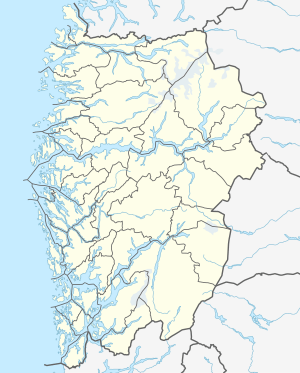 Fana Church Location of the church 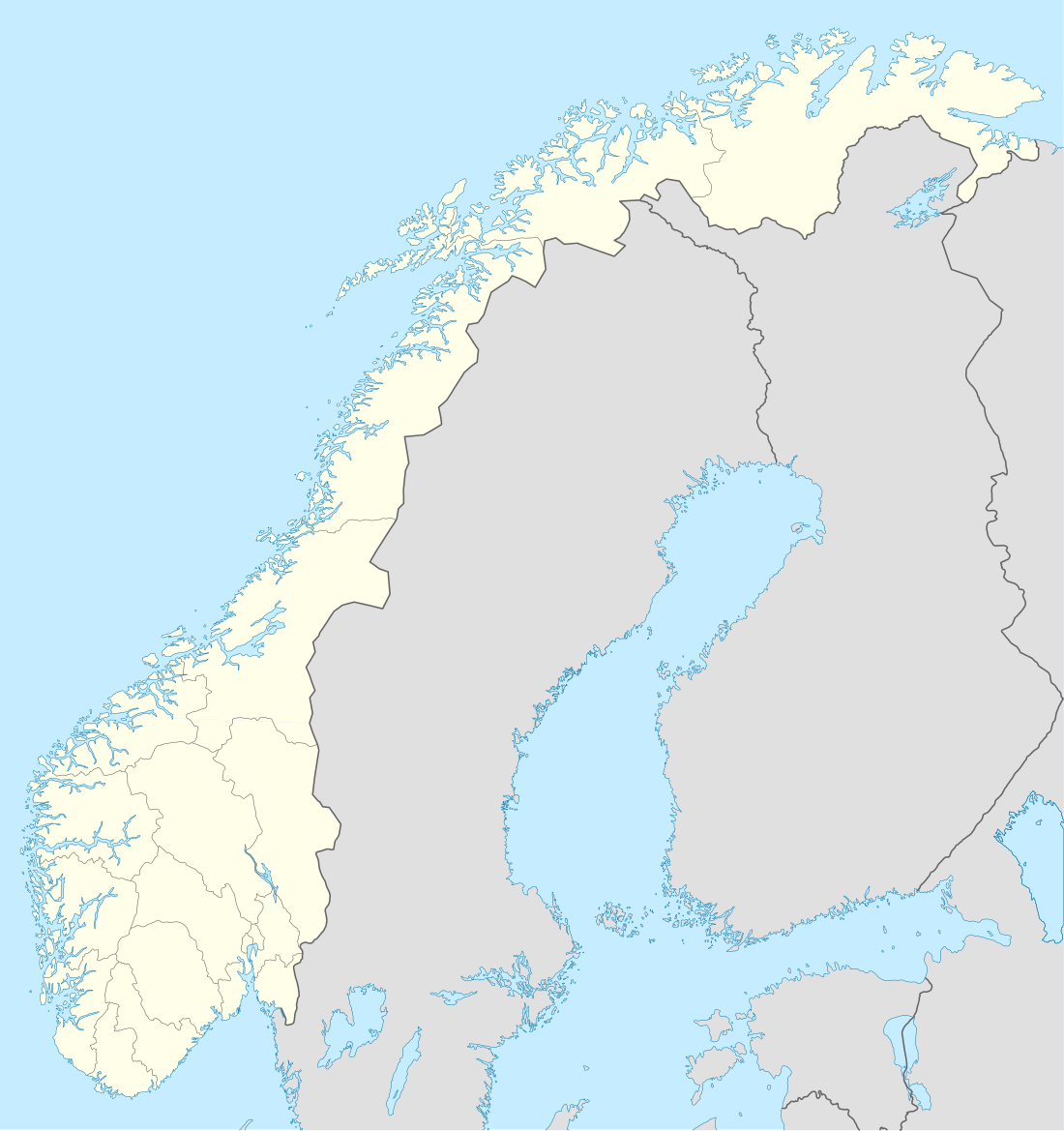 Fana Church Fana Church (Norway) | |
| 60.263394°N 5.348389°E | |
| Location | Bergen Municipality, Vestland |
| Country | Norway |
| Denomination | Church of Norway |
| Churchmanship | Evangelical Lutheran |
| History | |
| Status | Parish church |
| Architecture | |
| Functional status | Active |
| Architectural type | Long church |
| Completed | 1153 |
| Specifications | |
| Capacity | 450 |
| Materials | Stone |
| Administration | |
| Parish | Fana |
| Deanery | Fana prosti |
| Diocese | Bjørgvin bispedømme |
| Type | Church |
| Status | Automatically protected |
| ID | 84114 |
History
Fana Church was mentioned in writings for the first time in 1228, when Pope Gregory IX released a conscription to the vicar and brothers at "the holy cross church and hospital in Fana". In the letter, it is mentioned that the bishops in Bergen had let the church be founded again: "de novo fundari". Parts of the existing church building are from the Romance époque, and the walls show signs of there having been a stone building at the site, most likely a church, before 1220. Due to this, it is believed that the core of the church was built in the second half of the 12th century.[5][6][4][7]
Windows
The window painting telling the history of the church. The latest rebuilding of any magnitude was done as late as in 1927–28, when the window was changed. Window paintings by Bernhard Greve (1886-1962) illustrate the history of the church.[8]
- 1228: Fana Church is built after the christening of Norway by Saint Olaf.
- 1228: Conscription from Pope Gregory IX referenced The Holy Cross Church [9]
- 1537: The silver cross, other treasures and lead row are removed.
- 1644: The church burns after having been struck by lightning.[7]
- 1928: The church is re-consecrated after having been rebuilt.
Legend of the holy silver cross
The legend "The Holy Silver Cross" is connected to Fana church. In 1626, King Christian IV of Denmark commissioned the University of Copenhagen to register all historical objects and occurrences in Bjørgvin bishopric. Skonvig, the son of a priest, sent a letter about the legend.[4]
Two fishermen found a silver cross outside Korsneset along Korsfjorden. They tried to get the cross on land near Milde. However, the cross was too heavy to carry, so they knew the cross was meant for Fana. When they arrived at Fanahammeren, the cross was easy to carry. They brought it to the church where it was settled at the altar. One of the fishermen was blind, but when he touched the cross and scratched his eyes he gained sight again. The story about the healing cross reached many, and pilgrims visited the church hoping to be healed. It is said that at Krykkjehaugen, a small knoll close to the church, there were crutches and canes that pilgrims had left behind after having been healed at the cross. According to the legend, the priest in Fana burned six horse-loads of crutches in 1546.[4][10]
Ownership
Since Fana Church was rather big compared to other rural churches, some believe that the church was a county church in its early years. It is believed that the hospital next to the church was shut down around 1300.[6]
In 1303, Fana Church was one of 14 royal chapels after having been transferred from the Bishop in Bergen to the Apostle Church in Bergen. Fana Church is one of only 3 remaining royal chapels. In 1723, the royal deed was sold to two men from the parish, Nils Olson Austevoll and Vinsens Nilsson Nedre Titlestad. The church was privately held until 1862, when the parish bought it. The parish decided to rebuild the church in 1870–71. Major changes were done, but after some years it became apparent that rebuilding had been a mistake. In 1920, the architect Frederik Konow Lund (1889–1970) was hired, who tried to restore the church to the Medieval appearance it once had.[5][6][4][11]
Media gallery
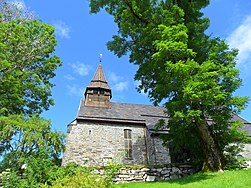 Exterior east side view
Exterior east side view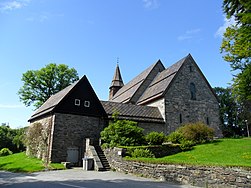 Exterior west side view
Exterior west side view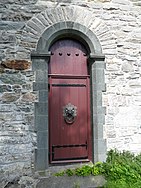 South side door
South side door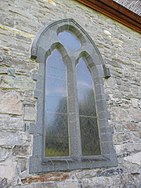 Window on south wall
Window on south wall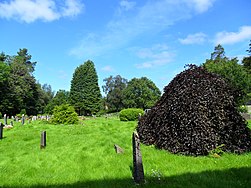 View of the church yard
View of the church yard- View of the front
See also
References
- "Fana kirke". Kirkesøk: Kirkebyggdatabasen. Retrieved 17 May 2020.
- "Oversikt over Nåværende Kirker" (in Norwegian). KirkeKonsulenten.no. Retrieved 17 May 2020.
- "Fana kirke". kunsthistorie. Retrieved 1 October 2016.
- "Fana kirke" (in Norwegian). Bergen Byarkiv. Retrieved 22 August 2014.
- "Fana kyrkje" (in Norwegian). DIS-Hordaland. Retrieved 22 August 2014.
- "Fana kirke" (in Norwegian). Norges Kirker. Retrieved 22 August 2014.
- "Fana kirkested" (in Norwegian). Norwegian Directorate for Cultural Heritage. Retrieved 18 May 2020.
- Tore Kirkholt. "Bernhard Henrik Greve". Store norske leksikon. Retrieved 1 October 2016.
- "Sagnet om det hellige sølvkorset". himmelfallen. Retrieved 1 October 2016.
- Geir Thorsnæs. "Korsfjorden". Store norske leksikon. Retrieved 1 October 2016.
- Trond Indahl. "Frederik Konow Lund". Norsk biografisk leksikon. Retrieved 1 October 2016.
External links
- Fana kirke – bygning og landskap (Marius Fugelsnes, Department of Archaeology and Religion. University in Bergen)